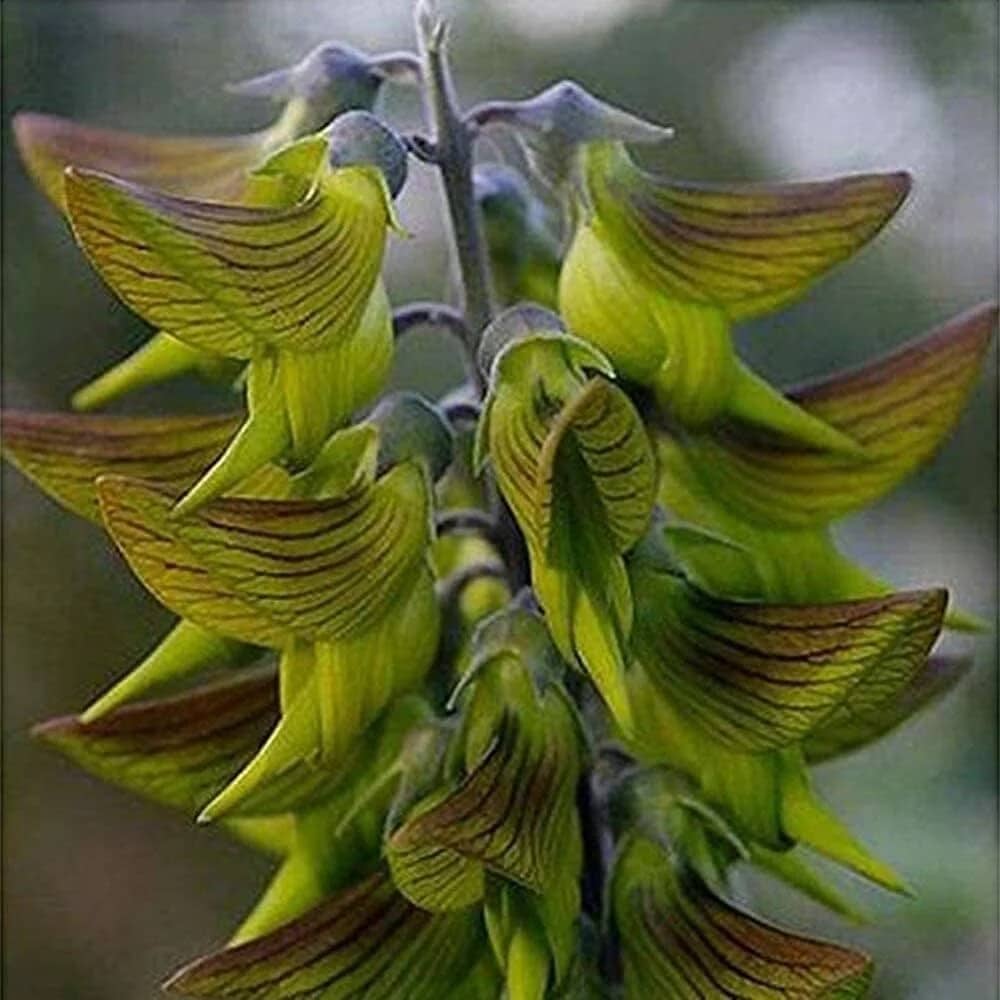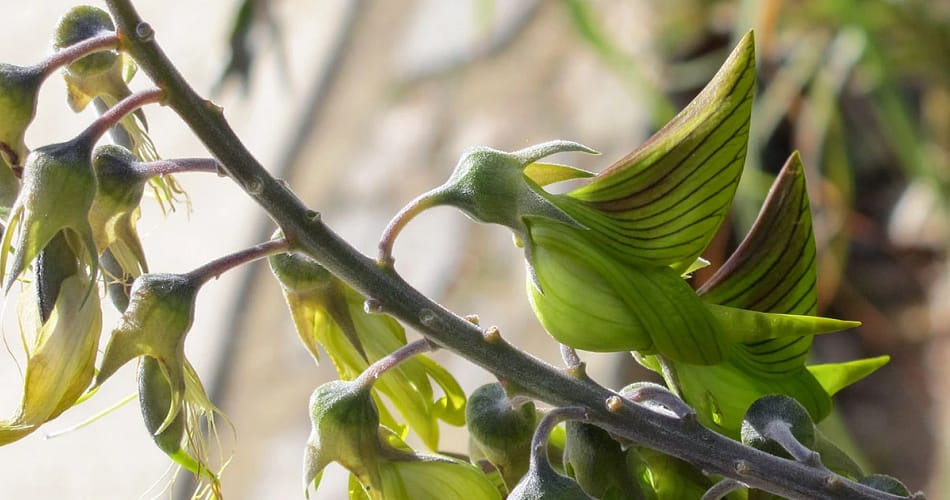The Green Bird Flower, scientifically known as Crotalaria cunninghamii, is a botanical marvel that captures the imagination of nature enthusiasts and botanists alike. This extraordinary plant, native to Australia, is renowned for its unique blossoms that strikingly resemble a hovering green bird. In this article, we delve into the fascinating characteristics, habitat, and ecological significance of the Plant.
Characteristics
This is a perennial herbaceous plant that can grow up to 2 meters tall. Its most striking feature is its flower, which has earned it the nickname “Green Bird Flower” due to its remarkable resemblance to a small, green bird in flight. The flowers are typically bright green with purple streaks, making them visually distinct.
Physical Description
- Flowers: The flowers are arranged in clusters, each flower measuring about 3 cm in length. They have a unique keel-like structure that mimics a bird’s body and wings.
- Leaves: The leaves of the plant are oval-shaped and grow in pairs along the stem.
- Stems: The plant has sturdy, upright stems that support the clusters of bird-like flowers.
Habitat and Distribution
This is indigenous to the arid and semi-arid regions of northern Australia, including Western Australia, the Northern Territory, and Queensland. It thrives in sandy soils and is often found in open woodlands, grasslands, and along riverbanks.
Growth Conditions
- Soil: Prefers well-drained sandy or loamy soils.
- Climate: Adapted to hot, dry climates and can tolerate drought conditions.
- Sunlight: Requires full sunlight for optimal growth and flowering.

Ecological Significance
It plays a crucial role in its native ecosystem. It is a part of the legume family, which means it can fix nitrogen in the soil, enriching it and benefiting other plants in the vicinity. Moreover, its flowers attract various pollinators, including bees and birds, which aid in the plant’s reproduction and the pollination of other flora.
Pollination
Pollinators are attracted to the Green Bird Flower’s bright green and purple flowers. Bees are particularly drawn to the nectar, while birds may be intrigued by the flower’s bird-like appearance. This mutualistic relationship helps in the propagation of the plant and supports the local biodiversity.
Cultivation and Uses
While the plant is primarily admired for its ornamental value, it also has practical uses. It can be cultivated in gardens and greenhouses, provided the right growing conditions are met.
Gardening Tips
- Planting: Sow seeds in well-drained soil with full sun exposure.
- Watering: Water sparingly, allowing the soil to dry out between watering sessions.
- Fertilizing: Utilize a balanced fertilizer to support healthy growth.
Conservation Status
Despite its ecological benefits and unique beauty, this plant is not currently listed as endangered. Nevertheless, habitat destruction and climate change present significant risks to its natural populations. Conservation efforts are essential to ensure that this remarkable plant continues to thrive in the wild.
FAQ
Scientifically known as Crotalaria cunninghamii, is a unique and fascinating plant that captures the interest of many gardening enthusiasts and botanists. Here are some frequently asked questions about this remarkable plant.
What is a Green Bird Flower?
It is a perennial herbaceous plant native to Australia. It is known for its striking flowers that resemble small green birds in flight.
Where can I find Green Bird Flowers?
These are indigenous to the arid and semi-arid regions of northern Australia, including Western Australia, the Northern Territory, and Queensland. They are typically found in sandy soils, open woodlands, grasslands, and along riverbanks.
How do Green Bird Flowers look?
Green Bird Flowers have bright green blossoms with purple streaks. The flowers are arranged in clusters, each flower measuring about 3 cm in length and resembling a bird in flight. The plant has oval-shaped leaves that grow in pairs along its sturdy, upright stems.
What are the ideal growing conditions for Green Bird Flowers?
Green Bird Flowers thrive in well-drained sandy or loamy soils and require full sunlight for optimal growth. They are adapted to hot, dry climates and can tolerate drought conditions.
Are Green Bird Flowers beneficial to the environment?
Yes, Green Bird Flowers are beneficial to the environment. They are part of the legume family, which means they can fix nitrogen in the soil, enriching it and benefiting other plants. Their flowers attract pollinators like bees and birds, aiding in plant reproduction and supporting local biodiversity.
Can Green Bird Flowers be grown outside Australia?
While the Green Bird Flower is native to Australia, it can be cultivated in other regions with similar climates. They require well-drained soil, full sunlight, and a dry environment to thrive. Growing them in greenhouses can also be an option in less suitable climates.
What threats do Green Bird Flowers face?
Although not currently listed as endangered, Green Bird Flowers face potential threats from habitat destruction and climate change. Conservation efforts are important to ensure the survival of this unique plant in its natural habitat.
What makes the Green Bird Flower unique?
The Green Bird Flower is unique due to its bird-like blossoms. The flowers’ shape and coloration make them look like green birds in flight, which is rare and captivating among flowering plants.
How can I help in the conservation of Green Bird Flowers?
You can help in the conservation of Green Bird Flowers by supporting habitat preservation efforts and advocating for climate action. Growing these plants in your garden and educating others about their ecological significance also contributes to their conservation.
Green Bird Flower, Crotalaria cunninghamii, perennial herbaceous plant, unique blossoms, native to Australia, striking flowers, bright green blossoms, purple streaks, oval-shaped leaves, arid regions, semi-arid regions, Western Australia, Northern Territory, Queensland, sandy soils, open woodlands, grasslands, riverbanks, well-drained soils, drought-tolerant plant, full sunlight, nitrogen-fixing, ecological significance, pollinators, bees, bird-like appearance, gardening tips, seed sowing, watering sparingly, balanced fertilizer, conservation status, habitat destruction, climate change, natural populations, conservation efforts, bird-like blossoms, nature’s ingenuity, healthy growth, botanical wonder, Australian flora, flowering plant, environmental impact, pollination process, unique plant species, Green Bird Flower cultivation, growing conditions, environmental benefits, garden cultivation, greenhouse cultivation, support local biodiversity, botanical marvel,Green Bird Flower, Crotalaria cunninghamii, perennial herbaceous plant, unique blossoms, native to Australia, botanical marvel, nature enthusiasts, botanists, flower clusters, bright green flowers, purple streaks, oval-shaped leaves, sturdy stems, arid regions, semi-arid regions, Western Australia, Northern Territory, Queensland, sandy soils, open woodlands, grasslands, riverbanks, well-drained soils, drought-tolerant plant, full sunlight, nitrogen-fixing, ecological significance, pollinators, bees, bird-like appearance, mutualistic relationship, local biodiversity, ornamental value, practical uses, garden cultivation, greenhouse cultivation, gardening tips, seed sowing, watering sparingly, balanced fertilizer, conservation status, habitat destruction, climate change, natural populations, conservation efforts, ecological benefits, bird-like blossoms, nature’s ingenuity, healthy growth, botanical wonder, preserving nature, unique plant species, Australian flora, flowering plant, environmental impact, pollination process, Green Bird Flower cultivation.

